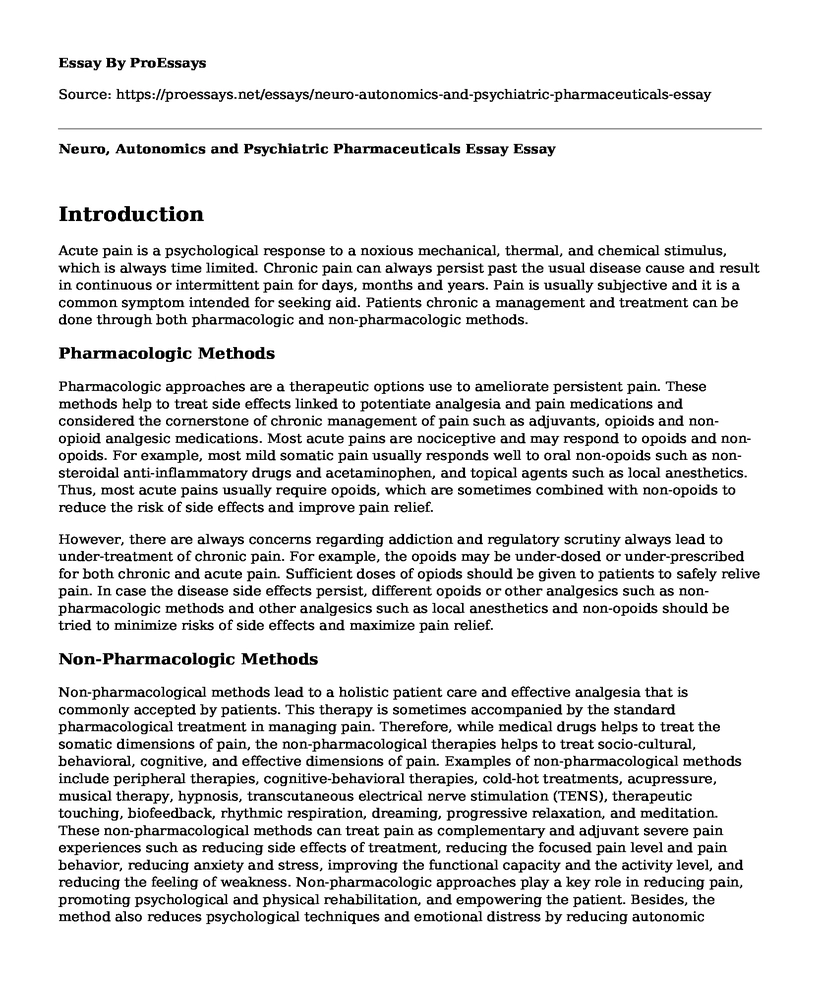Introduction
Acute pain is a psychological response to a noxious mechanical, thermal, and chemical stimulus, which is always time limited. Chronic pain can always persist past the usual disease cause and result in continuous or intermittent pain for days, months and years. Pain is usually subjective and it is a common symptom intended for seeking aid. Patients chronic a management and treatment can be done through both pharmacologic and non-pharmacologic methods.
Pharmacologic Methods
Pharmacologic approaches are a therapeutic options use to ameliorate persistent pain. These methods help to treat side effects linked to potentiate analgesia and pain medications and considered the cornerstone of chronic management of pain such as adjuvants, opioids and non-opioid analgesic medications. Most acute pains are nociceptive and may respond to opoids and non-opoids. For example, most mild somatic pain usually responds well to oral non-opoids such as non-steroidal anti-inflammatory drugs and acetaminophen, and topical agents such as local anesthetics. Thus, most acute pains usually require opoids, which are sometimes combined with non-opoids to reduce the risk of side effects and improve pain relief.
However, there are always concerns regarding addiction and regulatory scrutiny always lead to under-treatment of chronic pain. For example, the opoids may be under-dosed or under-prescribed for both chronic and acute pain. Sufficient doses of opiods should be given to patients to safely relive pain. In case the disease side effects persist, different opoids or other analgesics such as non-pharmacologic methods and other analgesics such as local anesthetics and non-opoids should be tried to minimize risks of side effects and maximize pain relief.
Non-Pharmacologic Methods
Non-pharmacological methods lead to a holistic patient care and effective analgesia that is commonly accepted by patients. This therapy is sometimes accompanied by the standard pharmacological treatment in managing pain. Therefore, while medical drugs helps to treat the somatic dimensions of pain, the non-pharmacological therapies helps to treat socio-cultural, behavioral, cognitive, and effective dimensions of pain. Examples of non-pharmacological methods include peripheral therapies, cognitive-behavioral therapies, cold-hot treatments, acupressure, musical therapy, hypnosis, transcutaneous electrical nerve stimulation (TENS), therapeutic touching, biofeedback, rhythmic respiration, dreaming, progressive relaxation, and meditation. These non-pharmacological methods can treat pain as complementary and adjuvant severe pain experiences such as reducing side effects of treatment, reducing the focused pain level and pain behavior, reducing anxiety and stress, improving the functional capacity and the activity level, and reducing the feeling of weakness. Non-pharmacologic approaches play a key role in reducing pain, promoting psychological and physical rehabilitation, and empowering the patient. Besides, the method also reduces psychological techniques and emotional distress by reducing autonomic nervous arousal and relaxing muscles. The method also helps to reinforce cycle of patient self-efficacy, a functional/rehabilitative outlook, realistic goal setting, and active problem-solving. Thus, non pharmacologic methods are the vehicles and control gates for pain, and help to improve chronic pain outcomes.
The major disadvantages of non-pharmacological techniques include factors related to resources, out-of-pocket cost, scheduling, and transportation. Another barrier include the knowledge and awareness of the non-pharmacologic methods since most healthcare providers and patients are unsure what non-pharmacologic methods such as behavioral therapy and cognitive behavioral therapy entail. Other barriers include motivation and medication related beliefs like the perception of patients on the effectiveness of the therapy is a critical barrier that have been reported in most studies.
Conclusion
A combination of both pharmacologic and non-pharmacologic methods is effective in chronic pain management. But from this point of view, the use of non-pharmacological methods for pain management is effective but study results that support its efficacy and efficiency may be required. Thus, incorporating both techniques in the treatment plan helps to address factors that may delay the disease outcome such as pain management, healing process, and drug side effect. Health care practitioners need to be educated about the alternative pain management tools that may be combined with pharmacologic techniques in the management of chronic pain.
Cite this page
Neuro, Autonomics and Psychiatric Pharmaceuticals Essay. (2022, Nov 06). Retrieved from https://proessays.net/essays/neuro-autonomics-and-psychiatric-pharmaceuticals-essay
If you are the original author of this essay and no longer wish to have it published on the ProEssays website, please click below to request its removal:
- Essay Example: Patient Safety Risks
- Juvenile Mental Health Court Recidivism Essay
- Wellness Programs: Nurses Motivation and Service Delivery Article Analysis
- Essay Example on Treating Anorexia & Bulimia: Same Strategies, Different Outcomes
- Paper Sample on 4 Studies Show How Exercise Can Help Alleviate Depression
- Support Group Proposal: Addressing Mental Health and Substance Abuse in Society
- Essay Sample on San Francisco's Queen of Vice







